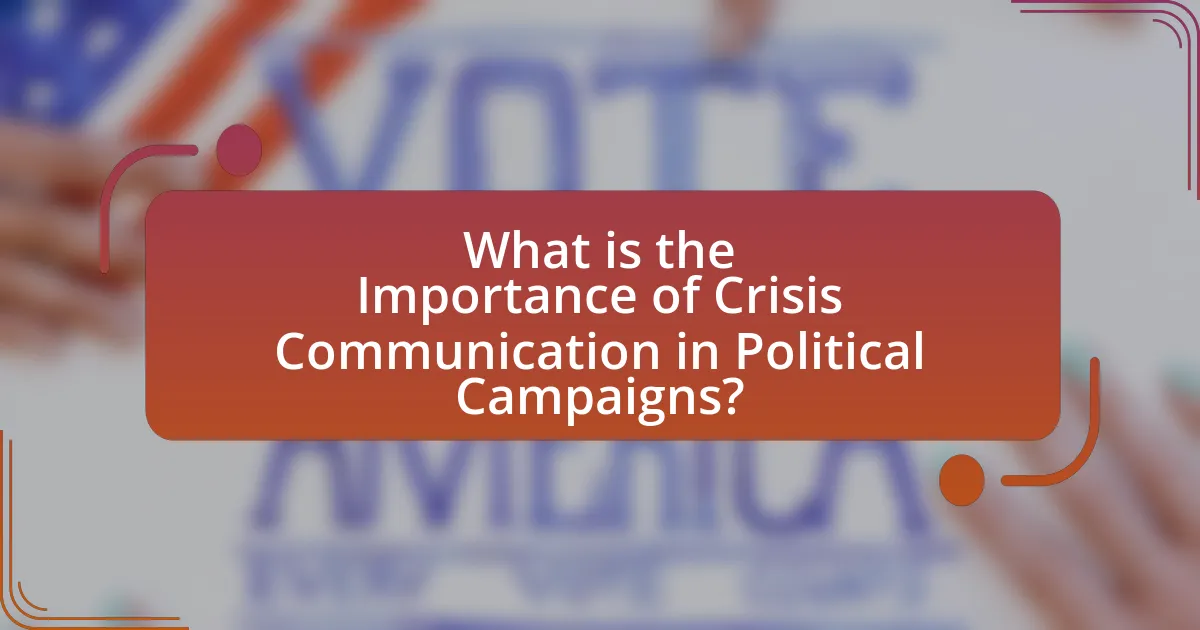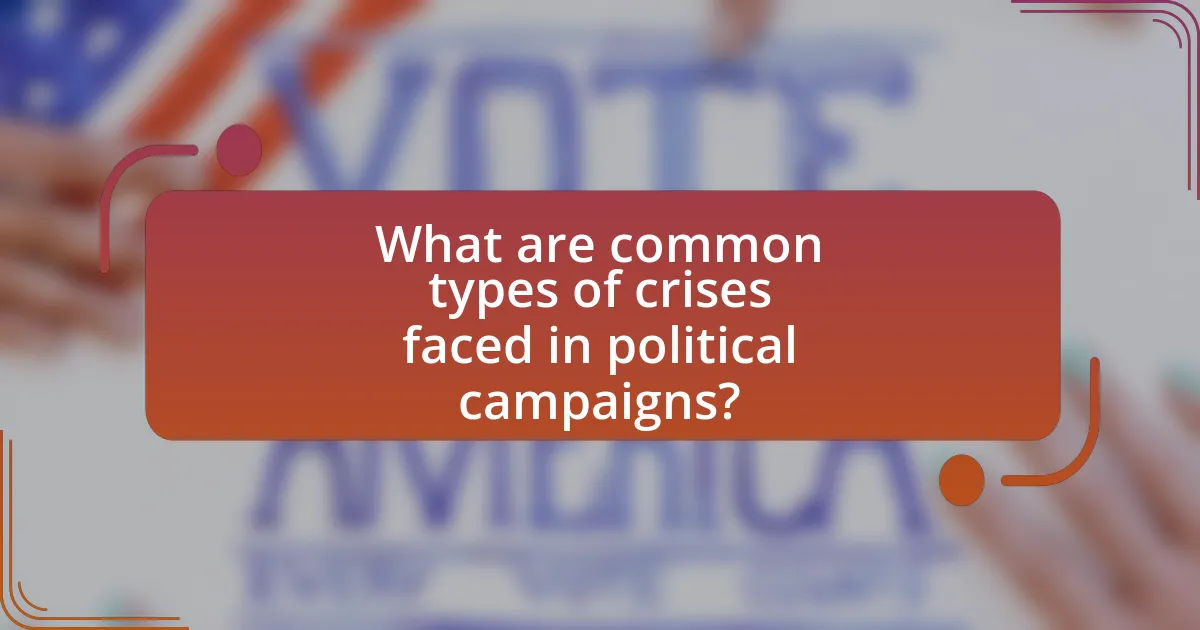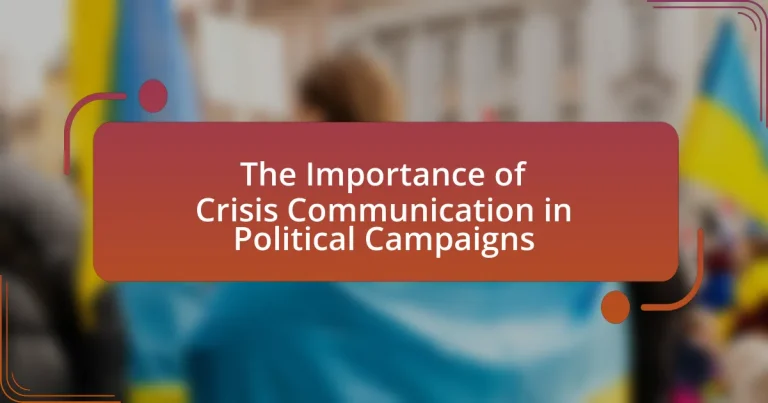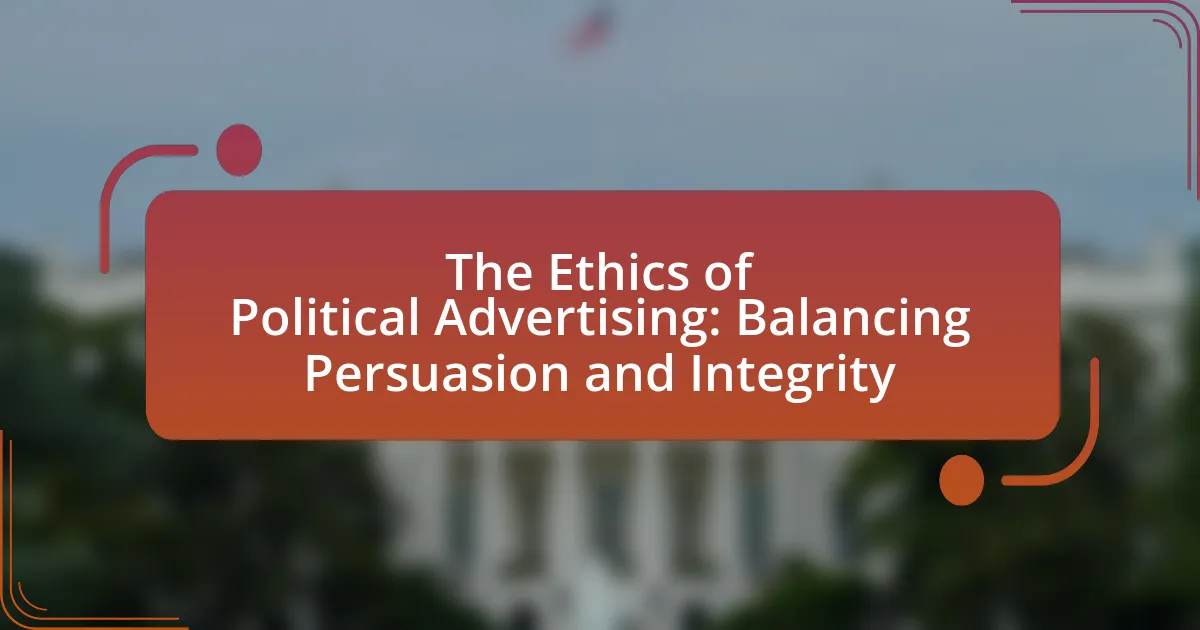Crisis communication is a vital component of political campaigns, essential for managing negative events and maintaining public trust. The article examines the significance of effective crisis communication strategies, highlighting historical examples such as Barack Obama’s 2008 campaign and the challenges faced by Hillary Clinton in 2016. It outlines the consequences of poor communication, the importance of timely and transparent messaging, and the key elements that contribute to successful crisis management. Additionally, the article discusses best practices for preparing for potential crises, the role of social media, and lessons learned from past political crises, emphasizing the need for campaigns to develop comprehensive communication plans to navigate challenging situations effectively.

What is the Importance of Crisis Communication in Political Campaigns?
Crisis communication is crucial in political campaigns as it helps manage and mitigate the impact of negative events or controversies. Effective crisis communication allows political candidates to maintain public trust, control the narrative, and respond swiftly to misinformation. For instance, during the 2008 U.S. presidential election, Barack Obama’s campaign effectively utilized crisis communication strategies to address controversies, which helped preserve his image and voter support. Research indicates that timely and transparent communication during crises can significantly influence public perception and voter behavior, underscoring the importance of having a robust crisis communication plan in place for political campaigns.
Why is crisis communication crucial during political campaigns?
Crisis communication is crucial during political campaigns because it helps manage and mitigate negative situations that can damage a candidate’s reputation and electoral chances. Effective crisis communication allows campaigns to respond swiftly to controversies, misinformation, or scandals, thereby maintaining public trust and support. For instance, during the 2008 U.S. presidential election, Barack Obama’s campaign effectively addressed the controversy surrounding his former pastor, Reverend Jeremiah Wright, by directly confronting the issue and clarifying his stance, which helped to minimize potential damage to his candidacy. This demonstrates that timely and transparent communication can significantly influence public perception and voter behavior during critical campaign periods.
What are the potential consequences of poor crisis communication?
Poor crisis communication can lead to significant reputational damage for political campaigns. When a campaign fails to effectively communicate during a crisis, it can result in misinformation spreading rapidly, eroding public trust and support. For instance, during the 2016 U.S. presidential election, poor handling of the email controversy by the Clinton campaign contributed to a decline in voter confidence, as reported by various polls. Additionally, ineffective communication can exacerbate the crisis, leading to prolonged media scrutiny and negative public perception, which can ultimately affect election outcomes.
How can effective crisis communication influence voter perception?
Effective crisis communication can significantly shape voter perception by providing timely, transparent, and accurate information during critical situations. When political campaigns manage crises effectively, they can mitigate negative impacts, maintain public trust, and reinforce their credibility. For instance, during the 2008 financial crisis, President Barack Obama’s administration utilized clear communication strategies to explain economic policies, which helped to bolster voter confidence in his leadership. Research indicates that voters are more likely to support candidates who demonstrate strong communication skills during crises, as it reflects their ability to handle pressure and make informed decisions.
What are the key elements of effective crisis communication in political campaigns?
The key elements of effective crisis communication in political campaigns include timely information dissemination, transparency, consistent messaging, and audience engagement. Timely information dissemination ensures that the campaign addresses issues as they arise, preventing misinformation from spreading. Transparency builds trust with the electorate, as seen in the 2008 Obama campaign, which openly communicated challenges and responses. Consistent messaging across all platforms reinforces the campaign’s stance and minimizes confusion, exemplified by the coordinated responses during the 2016 election controversies. Lastly, audience engagement through social media allows for real-time feedback and adaptation, which was crucial for campaigns like that of Donald Trump in 2016, where direct communication with supporters helped manage crises effectively.
What role does transparency play in crisis communication?
Transparency is crucial in crisis communication as it fosters trust and credibility between the organization and its stakeholders. When organizations openly share information during a crisis, they demonstrate accountability and a commitment to addressing the situation, which can mitigate negative perceptions and reduce misinformation. Research indicates that transparent communication can lead to a 20% increase in public trust during crises, as stakeholders feel more informed and engaged. This trust is essential in political campaigns, where public perception can significantly influence voter behavior and campaign success.
How important is timely communication during a crisis?
Timely communication during a crisis is crucial for effective crisis management and maintaining public trust. Research indicates that rapid dissemination of accurate information can significantly mitigate panic and misinformation, as seen during the COVID-19 pandemic, where timely updates from health authorities helped guide public behavior and compliance with safety measures. Furthermore, a study by the Harvard Kennedy School found that organizations that communicated promptly during crises were perceived as more trustworthy and competent, leading to better stakeholder relationships and outcomes.
How do political campaigns prepare for potential crises?
Political campaigns prepare for potential crises by developing comprehensive crisis communication plans that outline strategies for addressing various scenarios. These plans typically include identifying potential risks, establishing a crisis management team, and creating key messages tailored to different audiences. For instance, during the 2016 U.S. presidential election, campaigns utilized rapid response teams to quickly address misinformation and negative press, demonstrating the effectiveness of proactive crisis management. Additionally, campaigns often conduct simulations and training exercises to ensure team members are prepared to respond effectively under pressure, reinforcing the importance of readiness in maintaining public trust and mitigating damage.
What strategies can campaigns implement to anticipate crises?
Campaigns can implement proactive monitoring and risk assessment strategies to anticipate crises. By utilizing social media analytics and sentiment analysis tools, campaigns can track public opinion and identify potential issues before they escalate. For instance, a study by the Pew Research Center found that 69% of adults in the U.S. use social media, making it a critical platform for gauging public sentiment. Additionally, conducting regular scenario planning exercises allows campaigns to prepare for various crisis situations, ensuring they have predefined responses ready. This approach is supported by research from the Institute for Public Relations, which emphasizes the importance of preparedness in effective crisis management.
How can training and simulations enhance crisis communication readiness?
Training and simulations enhance crisis communication readiness by providing practical experience and developing strategic responses to potential crises. These methods allow individuals and teams to practice real-time decision-making, refine messaging, and improve coordination under pressure. Research indicates that organizations that engage in regular crisis simulations are 30% more effective in managing actual crises compared to those that do not. This effectiveness stems from the ability to identify weaknesses in communication strategies and address them proactively, ensuring that all stakeholders are prepared and informed during a crisis.

What are common types of crises faced in political campaigns?
Common types of crises faced in political campaigns include scandals, misinformation, candidate gaffes, and external events such as natural disasters. Scandals often involve personal misconduct or unethical behavior that can damage a candidate’s reputation, as seen in the Bill Clinton impeachment case. Misinformation can spread rapidly through social media, impacting public perception, exemplified by the false claims during the 2016 U.S. presidential election. Candidate gaffes, such as inappropriate comments or actions, can lead to significant backlash, as demonstrated by various instances in past campaigns. External events, like natural disasters, can disrupt campaign activities and require swift communication strategies to address public concerns, as observed during Hurricane Sandy in 2012.
What are the most frequent crises encountered by political candidates?
Political candidates frequently encounter crises such as scandals, gaffes, negative media coverage, and opposition attacks. Scandals, including personal misconduct or unethical behavior, can severely damage a candidate’s reputation and campaign. Gaffes, or verbal missteps, often lead to public backlash and can shift voter perception. Negative media coverage can amplify these issues, creating a narrative that undermines a candidate’s message. Additionally, opposition attacks, whether through advertisements or debates, can exploit vulnerabilities and create further challenges. These crises necessitate effective crisis communication strategies to mitigate damage and restore public trust.
How do scandals impact a political campaign’s crisis communication strategy?
Scandals significantly alter a political campaign’s crisis communication strategy by necessitating rapid response and damage control measures. When a scandal arises, campaigns must quickly assess the situation, formulate a clear message, and communicate transparently to mitigate negative perceptions. For instance, during the 2016 U.S. presidential election, the Clinton campaign faced challenges due to the email controversy, prompting them to adopt a strategy focused on transparency and addressing the issue head-on to regain public trust. This illustrates that effective crisis communication in the face of scandals often involves acknowledging the issue, providing factual information, and outlining steps taken to rectify the situation, thereby aiming to restore credibility and maintain voter support.
What role do social media crises play in modern political campaigns?
Social media crises significantly impact modern political campaigns by shaping public perception and influencing voter behavior. These crises can arise from negative publicity, misinformation, or scandals that spread rapidly across platforms like Twitter and Facebook. For instance, during the 2016 U.S. presidential election, the rapid dissemination of false information on social media platforms affected candidate reputations and voter opinions, demonstrating the power of social media in crisis situations. Additionally, research by the Pew Research Center indicates that 64% of Americans believe social media has a major impact on political outcomes, underscoring the critical role these platforms play in crisis communication strategies for campaigns.
How can campaigns effectively respond to crises?
Campaigns can effectively respond to crises by implementing a structured communication strategy that prioritizes transparency, timely updates, and audience engagement. This approach ensures that the campaign addresses the issue directly, provides accurate information, and maintains public trust. For instance, during the 2016 U.S. presidential election, the Clinton campaign faced multiple crises, including the email controversy. They responded by holding press conferences and releasing statements to clarify their position, which helped mitigate damage and maintain voter confidence. Research indicates that campaigns that communicate openly during crises can reduce negative perceptions by up to 30%, demonstrating the effectiveness of proactive crisis management.
What steps should be taken immediately following a crisis event?
Immediately following a crisis event, the first step is to assess the situation to understand the scope and impact of the crisis. This involves gathering accurate information about what occurred, identifying affected parties, and determining immediate risks. Next, a clear and concise communication plan should be developed to inform stakeholders, including the public, media, and internal teams, about the situation and the steps being taken to address it. This communication should be timely, transparent, and consistent to maintain trust and credibility. Additionally, it is crucial to establish a crisis management team that includes key decision-makers who can coordinate the response effectively. Research indicates that organizations that communicate promptly and transparently during crises can mitigate reputational damage and maintain stakeholder confidence.
How can campaigns maintain control of the narrative during a crisis?
Campaigns can maintain control of the narrative during a crisis by implementing a proactive communication strategy that includes timely messaging, consistent updates, and direct engagement with the audience. This approach allows campaigns to shape the conversation and counter misinformation effectively. For instance, during the 2016 U.S. presidential election, the Clinton campaign utilized rapid response teams to address emerging issues quickly, which helped to mitigate potential damage to their narrative. By prioritizing transparency and addressing concerns head-on, campaigns can reinforce their message and maintain public trust even in challenging situations.

What are the best practices for crisis communication in political campaigns?
The best practices for crisis communication in political campaigns include timely and transparent communication, consistent messaging, and proactive engagement with the media and public. Timely communication ensures that the campaign addresses issues before they escalate, as seen in the 2008 Obama campaign, which effectively managed controversies by quickly responding to allegations. Transparency builds trust; for example, the 2016 Clinton campaign faced challenges due to perceived opacity regarding email controversies, highlighting the need for openness. Consistent messaging across all platforms prevents mixed signals, as demonstrated by successful campaigns that maintained a unified narrative during crises. Proactive media engagement allows campaigns to shape the narrative rather than react to it, a strategy effectively employed by various political figures who held press conferences to clarify their positions. These practices are essential for maintaining credibility and voter trust during challenging times.
How can campaigns develop a crisis communication plan?
Campaigns can develop a crisis communication plan by identifying potential risks, establishing a clear communication framework, and training spokespersons. First, campaigns should conduct a risk assessment to identify scenarios that could lead to a crisis, such as scandals or negative media coverage. Next, they must create a communication framework that outlines key messages, target audiences, and communication channels to be used during a crisis. Additionally, training spokespersons ensures they can effectively convey messages and respond to media inquiries. Research indicates that campaigns with a well-defined crisis communication plan can mitigate damage and maintain public trust, as seen in the 2016 U.S. presidential election where candidates with proactive strategies managed crises more effectively.
What key components should be included in a crisis communication plan?
A crisis communication plan should include key components such as a clear communication strategy, designated spokespersons, a stakeholder communication list, pre-prepared messages, and a monitoring system. The communication strategy outlines how information will be disseminated during a crisis, ensuring consistency and clarity. Designated spokespersons are crucial for maintaining a unified voice and managing public perception. A stakeholder communication list identifies key audiences, including media, supporters, and internal teams, to ensure timely updates. Pre-prepared messages allow for rapid response, reducing the risk of misinformation. Finally, a monitoring system tracks media coverage and public sentiment, enabling adjustments to the communication strategy as needed. These components are essential for effective crisis management, as evidenced by successful political campaigns that have navigated crises by adhering to structured communication plans.
How can campaigns ensure all team members are aligned in crisis situations?
Campaigns can ensure all team members are aligned in crisis situations by implementing a clear communication strategy that includes regular updates, defined roles, and a centralized information hub. This approach allows team members to receive consistent messaging and understand their specific responsibilities during a crisis. Research indicates that effective communication in high-pressure environments can reduce confusion and enhance team cohesion, as seen in studies by the Institute for Crisis Management, which highlight that organizations with structured communication plans experience quicker resolution times and improved team performance.
What lessons can be learned from past political crises?
Past political crises reveal the critical importance of effective communication strategies. For instance, during the Watergate scandal, the Nixon administration’s failure to communicate transparently led to a significant loss of public trust and ultimately his resignation. Similarly, the handling of the 2008 financial crisis demonstrated that timely and clear communication from leaders can mitigate panic and maintain public confidence. These examples underscore that proactive and honest communication is essential in managing crises, as it helps to preserve credibility and stabilize public sentiment.
What are some notable examples of successful crisis communication in politics?
Notable examples of successful crisis communication in politics include Barack Obama’s response to the 2008 financial crisis and Jacinda Ardern’s handling of the Christchurch mosque shootings in 2019. During the financial crisis, Obama effectively communicated a message of hope and recovery, emphasizing transparency and action, which helped to stabilize public confidence. In the aftermath of the Christchurch shootings, Ardern demonstrated empathy and decisiveness, quickly addressing the nation and implementing gun control measures, which garnered widespread approval and support. These instances illustrate how effective communication strategies can mitigate crises and reinforce public trust in leadership.
What mistakes have been made in crisis communication, and what can be learned from them?
Mistakes in crisis communication often include delayed responses, lack of transparency, and failure to address the audience’s concerns. For instance, during the 2010 BP oil spill, the company’s slow and inadequate response led to public outrage and damaged its reputation significantly. This incident illustrates the importance of timely communication; organizations must respond quickly to mitigate misinformation and maintain trust. Additionally, the lack of transparency can exacerbate crises, as seen in the case of the 2015 Volkswagen emissions scandal, where initial denial and obfuscation led to greater backlash. Learning from these mistakes emphasizes the need for proactive communication strategies, clear messaging, and genuine engagement with stakeholders to effectively manage crises in political campaigns.
What practical tips can enhance crisis communication in political campaigns?
To enhance crisis communication in political campaigns, campaigns should prioritize transparency, timely responses, and consistent messaging. Transparency builds trust; for instance, when a candidate openly addresses a controversy, it can mitigate backlash. Timely responses are crucial; research indicates that addressing issues within the first 24 hours can significantly reduce negative perceptions. Consistent messaging ensures that all team members convey the same narrative, preventing mixed signals that can confuse voters. Additionally, utilizing multiple communication channels, such as social media, press releases, and direct outreach, allows campaigns to reach diverse audiences effectively.
How can campaigns effectively utilize social media during a crisis?
Campaigns can effectively utilize social media during a crisis by maintaining transparent communication, providing timely updates, and engaging directly with their audience. Transparency builds trust; for instance, during the COVID-19 pandemic, political figures who openly shared information about their responses saw increased public confidence. Timely updates are crucial; research indicates that 70% of people expect brands to communicate during a crisis, highlighting the need for campaigns to keep their followers informed. Engaging directly with the audience allows campaigns to address concerns and questions, fostering a sense of community and support. This approach not only mitigates misinformation but also strengthens the campaign’s credibility during challenging times.
What role does audience analysis play in crisis communication strategies?
Audience analysis is crucial in crisis communication strategies as it enables communicators to tailor their messages effectively to different stakeholder groups. By understanding the demographics, values, and concerns of the audience, political campaigns can craft targeted messages that resonate and address specific fears or misinformation. For instance, during a crisis, a study by the Pew Research Center found that 63% of Americans prefer receiving information from trusted sources, highlighting the need for campaigns to identify and utilize credible voices within their audience. This targeted approach not only enhances message clarity but also fosters trust and engagement, ultimately leading to more effective crisis management.




